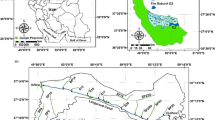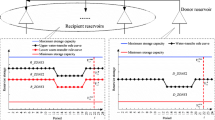Abstract
During a certain water distribution process in irrigated areas, the water resource allocation model can generate the distribution scheme of different water users in different regions to obtain the different water distributions of the canals that supply water to the water users. Based on the amount of water distribution, the canal optimization water distribution model was established, and indicators such as water allocation duration and leakage loss were obtained. Leakage loss affects the net water allocation of users and then affects the water fee income and equity of the water resource allocation model. Therefore, the water resource allocation model and canal optimization water distribution model are mutually influenced. The coupled model should be considered while modelling the process of water distribution to obtain more reasonable water resource allocation results. The coupled model comprehensively considers the objectives of water fee income, equity, leakage loss and water distribution duration, and the results can help irrigation area managers obtain a more practical water distribution scheme. The applicability and practicability of the method were verified by applying the model to the limited water resource allocation scenario in the BoJiLi Yellow River irrigation area. The results showed that the coupled model provides a promising way of optimizing the water distribution scheme, i.e., less water leakage losses, more total water allocation guarantees, less total water shortages, and more irrigated water from the reservoir (upstream) to farmland (downstream), thus promoting fairness and increasing the water fee income.






Similar content being viewed by others
Data Availability
Data sharing does not apply to this article, as no datasets were generated or analysed during the current study.
References
Ahmad I, Zhang F (2022) Optimal Agricultural Water Allocation for the Sustainable Development of Surface and Groundwater Resources. Water Resour Manage 36:4219–4236. DOI: https://doi.org/10.1007/s11269-022-03249-3
Banihabib ME, Tabari MR, Mahmoud MR, Tabari, Mohsen (2019) Development of a fuzzy Multi-Objective Heuristic Model for Optimum Water Allocation. Water Resour Manage 33:3673–3689. https://doi.org/10.1007/s11269-019-02323-7
Das B, Singh A, Panda SN, Yasuda H (2015) Optimal land and water resources allocation policies for sustainable irrigated agriculture. Land Use Policy 42:527–537. https://doi.org/10.1016/j.landusepol.2014.09.012
Deb K, Pratap A, Agarwal S, Meyarivan T (2002) A fast and elitist multi-objective genetic algorithm: NSGA-II. IEEE Trans Evol Computat 6:182–197. https://doi.org/10.1109/4235.996017
Dhakal R, Zhou J, Palikhe S, Bhattarai KP (2020) Hydraulic optimization of double chamber surge tank using NSGA-II. Water 12:455. https://doi.org/10.3390/w12020455
Fadaeizadeh K, Shourian M (2019) Determination of the Optimal River Basin-Wide Agricultural Water demand quantities meeting satisfactory reliability levels. Water Resour Manage 33:2665–2676. https://doi.org/10.1007/s11269-019-02242-7
Fu Y, Li M, Guo P (2014) Optimal allocation of water resources model for different growth stages of crops under uncertainty. J Irrig Drain Eng 140(6):05014003. https://doi.org/10.1061/(ASCE)IR.1943-4774.0000724
Giacomoni MH, Joseph J (2017) Multi-objective evolutionary optimization and Monte Carlo simulation for placement of low impact development in the catchment scale. J Water Resour Plann Manage 143:04017053. https://doi.org/10.1061/(ASCE)WR.1943-5452.0000812
Guo Y (2009) Farmland Hydrology. China Water & Power Press, Beijing, China
Jia B, Zhong P, Wan X, Xu B, Chen J (2015) Decomposition–coordination model of reservoir group and flood storage basin for real-time flood control operation. Hydrol Res 46:11–25. https://doi.org/10.2166/nh.2013.391
Jiang Y, Xu X, Huang Q, Huo Z, Huang G (2016) Optimizing regional irrigation water use by integrating a two-level optimization model and an agro-hydrological model. Agric Water Manag 178:76–88. https://doi.org/10.1016/j.agwat.2016.08.035
Kazemi M, Bozorg-Haddad O, Fallah-Mehdipour E, Chu X (2022) Optimal water resources allocation in transboundary river basins according to hydropolitical consideration. Environ Dev Sustain 24:1188–1206. https://doi.org/10.1007/s10668-021-01491-0
KhazaiPoul A, Moridi A, Yazdi J (2019) Water Resour Manage 33:5137–5151. https://doi.org/10.1007/s11269-019-02420-7. Multi-Objective Optimization for Interactive Reservoir-Irrigation Planning Considering Environmental Issues by Using Parallel Processes Technique
Kanooni A, Monem MJ (2014) Integrated stepwise approach for optimal water allocation in irrigation canals. Irrig Drain 63:12–21. https://doi.org/10.1002/ird.1798
Li AL (2004) A study on the large-scale system decomposition—coordination method used in optimal operation of a hydroelectric system. Water Int 29:228–231. https://doi.org/10.1080/02508060408691772
Marques GF, Lund JR, Howitt RE (2010) Modeling conjunctive use operations and farm decisions with two-stage stochastic quadratic programming. J Water Resour Plann Manage 136:386–394. https://doi.org/10.1061/(ASCE)WR.1943-5452.0000045
Pawde AW, Mathur YP, Kumar R (2013) Optimal water scheduling in irrigation canal network using particle swarm optimization. Irrig Drain 62:135–144. https://doi.org/10.1002/ird.1707
Rezaee A, Bozorg-Haddad O, Chu X (2021) Reallocation of water resources according to social, economic, and environmental parameters. Sci Rep 11:17514. https://doi.org/10.1038/s41598-021-96680-2
Sethi LN, Panda SN, Nayak MK (2006) Optimal crop planning and water resources allocation in a coastal groundwater basin. Orissa India Agric Water Manag 83:209–220. https://doi.org/10.1016/j.agwat.2005.11.009
Singh A, Singh A (2015) Land and water management planning for increasing farm income in irrigated dry areas. Land Use Policy 42:244–250. https://doi.org/10.1016/j.landusepol.2014.08.006
Suryavanshi AR, Reddy JM (1986) Optimal operation schedule of irrigation distribution systems. Agric Water Manag 11:23–30. https://doi.org/10.1016/0378-3774(86)90033-8
Tian J, Guo S, Liu D, Pan Z, Hong X (2019) A Fair Approach for Multi-Objective Water Resources Allocation. Water Resour Manage 33:3633–3653. https://doi.org/10.1007/s11269-019-02325-5
Wang Z, Reddy JM, Feyen J (1995) Improved 0–1 programming model for optimal flow scheduling in irrigation canals. Irrigat Drain Syst 9:105–116. https://doi.org/10.1007/BF00881670
Xu X, Huang G, Qu Z, Pereira LS (2011) Using MODFLOW and GIS to assess changes in groundwater dynamics in response to water saving measures in irrigation districts of the primary Yellow River Basin. Water Resour Manag 25:2035–2059. https://doi.org/10.1007/s11269-011-9793-2
Yan Z, Liao S, Cheng C, Zhou L, Chen F (2020) Long-term optimization of large-scale hydropower system operations based on decomposition-coordination. J Water Resour Plann Manage 146:04020078. https://doi.org/10.1061/(ASCE)WR.1943-5452.0001288
Yao W, Ma X, Chen Y (2019) Optimization of Canal water in an irrigation network based on a genetic algorithm: a case study of the north china plain canal system. Irrig Drain 68:629–636. https://doi.org/10.1002/ird.2345
Yue W, Yu S, Xu M et al (2022) A copula-based interval linear programming model for water resources allocation under uncertainty[J]. J Environ Manage 317:115318. DOI: https://doi.org/10.1016/j.jenvman.2022.115318
Yun R, ZengChuan D, Haofang W (2010) Multi-objective optimization of a reservoir based on NSGA2. J Shandong Univ 40:124–128 (in Chinese)
Yuan F, Berndtsson R, Zhang L, Uvo CB, Hao Z, Wang X, Yasuda H (2015) Hydro Climatic Trend and Periodicity for the source region of the Yellow River. J Hydrol Eng 20:05015003. https://doi.org/10.1061/(ASCE)HE.1943-5584.0001182
Zeinali M, Azari A, Heidari MM (2020) Multi-objective optimization for water resource management in low-flow areas based on a coupled surface water–groundwater model. J Water Resour Plann Manage 146:04020020. https://doi.org/10.1061/(ASCE)WR.1943-5452.0001189
Zhang X, Guo P, Zhang F, Liu X, Yue Q, Wang Y (2021) Optimal irrigation water allocation in Hetao Irrigation District considering decision makers’ preference under uncertainties. Agric Water Manag 246:106670. https://doi.org/10.1016/j.agwat.2020.106670
Funding
This work is funded jointly by the Innovation Team Project of China Institute of Water Resources and Hydropower Research (ID0145B022021), Key Science and Technology Project for Revitalization of Inner Mongolia, China (2022EEDSKJXM004, 2021EEDSCXSFQZD010), and the National Natural Science Foundation Program of China (Grant Nos. 52109073).
Author information
Authors and Affiliations
Contributions
All authors contributed to this paper. Yu Fan contributed to the conception of the study and the data analysis; Haorui Chen contributed to improving the model and checking the article; Zhanyi Gao contributed significantly to the analysis and manuscript preparation; Benyan Fang and Xiangkun Liu introduced the actual situation of the irrigation area and provided data. The first draft of the manuscript was written by Yu Fan, and all authors commented on previous versions of the manuscript. All authors read and approved the final manuscript.
Corresponding author
Ethics declarations
Ethical approval
Informed Consent for publication of this paper was obtained from all authors. No other ethical issues were addressed in this study.
Consent to Participate
Written informed consent was obtained from all participants.
Consent to Publish
All authors gave their consent for publication.
Competing Interests
The authors declare that there are no conflicts of interest.
Additional information
Publisher’s Note
Springer Nature remains neutral with regard to jurisdictional claims in published maps and institutional affiliations.
Rights and permissions
Springer Nature or its licensor (e.g. a society or other partner) holds exclusive rights to this article under a publishing agreement with the author(s) or other rightsholder(s); author self-archiving of the accepted manuscript version of this article is solely governed by the terms of such publishing agreement and applicable law.
About this article
Cite this article
Fan, Y., Chen, H., Gao, Z. et al. A Model Coupling Water Resource Allocation and Canal Optimization for Water Distribution. Water Resour Manage 37, 1341–1365 (2023). https://doi.org/10.1007/s11269-023-03437-9
Received:
Accepted:
Published:
Issue Date:
DOI: https://doi.org/10.1007/s11269-023-03437-9




